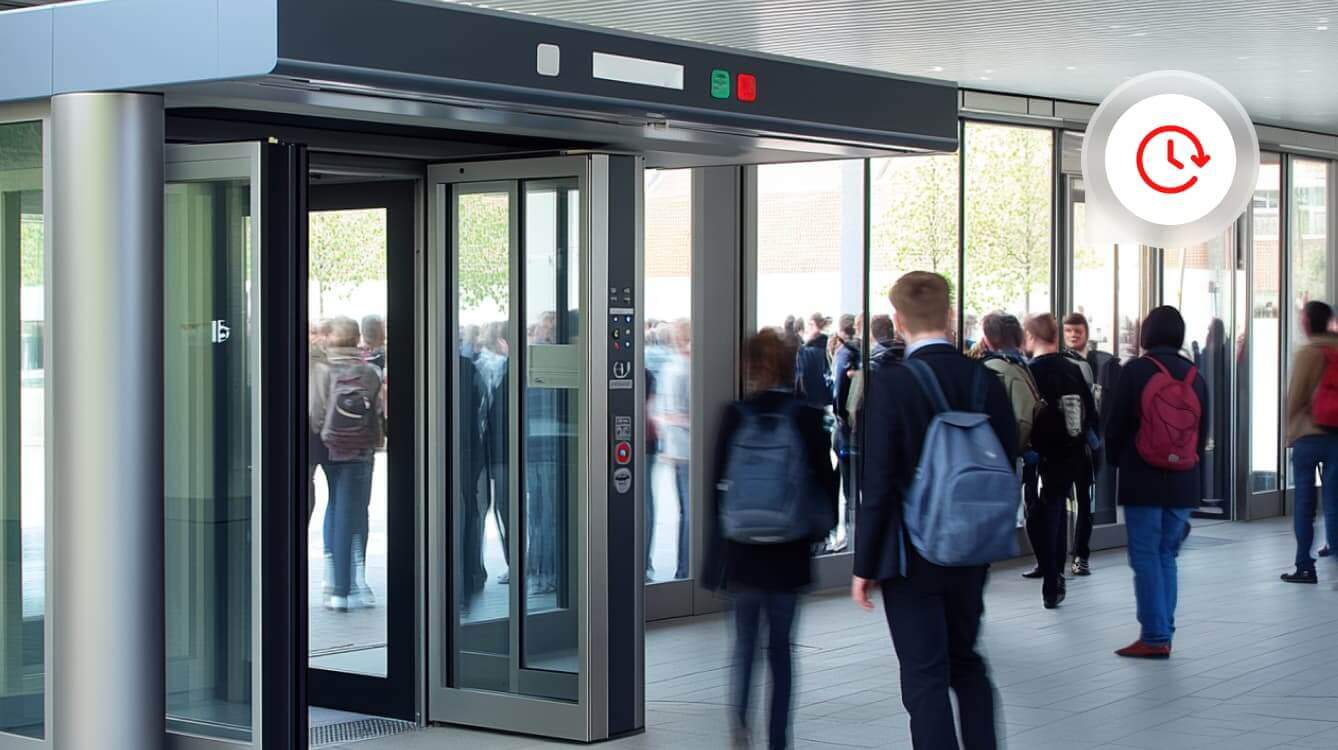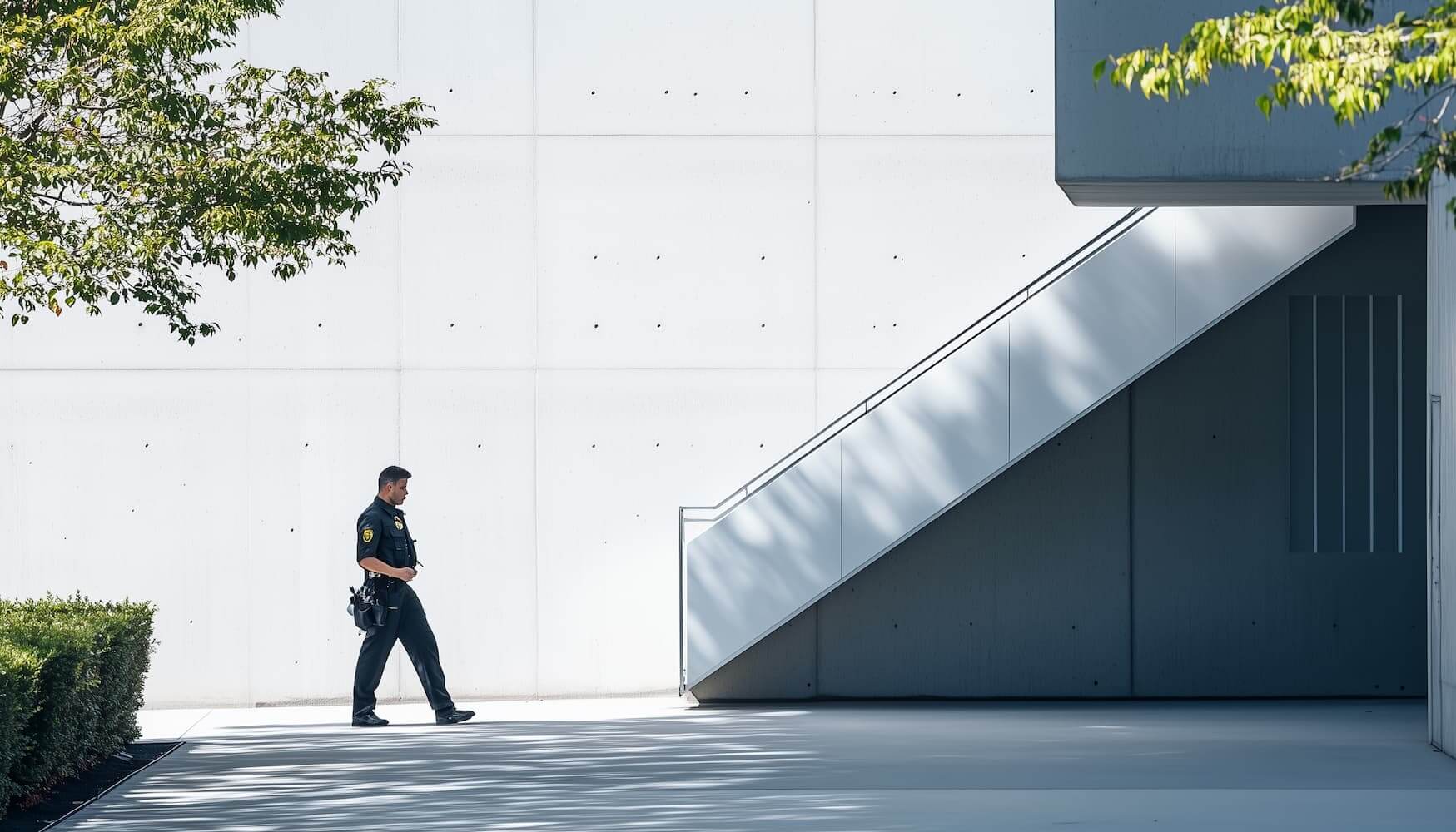Weapon detection in schools has become a critical component of campus safety strategies across the United States. As educational institutions grapple with the challenge of maintaining a secure learning environment, various weapon detection methods have been developed and implemented.
These range from traditional approaches like metal detectors and security personnel to cutting-edge technologies such as AI-powered surveillance systems. The effectiveness of weapon detection measures can significantly impact school safety, potentially preventing tragic incidents and providing peace of mind to students, staff, and parents alike.
This overview examines the evolution, current state, and efficacy of different weapon detection techniques employed in educational settings, highlighting both their strengths and limitations in addressing the complex issue of school security.
Learn how real public schools have implemented VOLT AI.
1. Entrance Scanners & Metal Detectors
Metal detectors have been a common security measure in schools for decades, but their effectiveness is somewhat mixed. When considering newer AI-powered weapon detection systems alongside traditional metal detectors, we see a shift in both capabilities and effectiveness. Let's break this down:
Traditional Metal Detectors can be quite effective at detecting metal objects, including most weapons and they do act as a visible deterrent, potentially discouraging some from bringing weapons to school.

Unfortunately, they come with a whole host of limitations:
- Can be time-consuming, causing bottlenecks at entrances
- May create a prison-like atmosphere in schools
- Can be bypassed if not constantly monitored
- May give false positives for harmless metal objects
- Effectiveness depends heavily on proper use and trained personnel
Occasionally schools will pair metal detectors with x-ray scanners that look for objects in backpacks, similar to the way an airport operates. New technology has been introduced that makes this less of a bottleneck. Some providers have incorporated AI into their tools and gotten rid of the need to scan individual backpacks, instead being able to detect weapons as a large volume of individuals walk through the entry points.
Providers like Evolv and Sound Thinking use AI to detect weapons as individuals pass through a defined entryway. While the addition of AI to the traditional metal detector route does make it easier to move a larger volume of individuals through a screening point more quickly, it comes with similar drawbacks to traditional metal detectors.
2. Security Personnel
Many schools choose to employ security personnel, typically referred to as Security Resource Officers (SROs), trained guards who may conduct visual inspections and bag checks.

The effectiveness of security personnel in detecting weapons at schools can vary widely based on several factors:
- Training and experience: Well-trained, experienced personnel are generally more effective at detecting suspicious behavior and potential threats. That effectiveness increases with specialized training in weapon detection and threat assessment.
- Alertness and diligence: Consistently maintaining high levels of vigilance is crucial but challenging over long periods, and effectiveness can decrease due to fatigue or complacency, especially in low-incident environments.
- Visual inspection: Skilled personnel can spot suspicious bulges in clothing or unusual behavior. However, well-concealed weapons may be missed through visual inspection alone.
- Bag checks: These can be effective for detecting larger weapons but smaller weapons or well-hidden items might be missed.
- Behavioral detection: Trained officers can sometimes spot suspicious behavior indicative of someone carrying a weapon, though this skill is highly dependent on the individual officer's training and intuition.
SROs tend to create a deterrent effect, where the visible presence of security personnel can deter some individuals from bringing weapons to school.
Generally, security personnel are most effective when working in conjunction with technological solutions like AI-powered surveillance. Using SROs alone means that human error is always a factor.
It is impossible to thoroughly check every individual without causing significant disruptions, and effectiveness can be influenced by personal biases or profiling concerns. That said, hard data on the specific effectiveness of security personnel in weapon detection is limited.
Overall, while security personnel can play a crucial role in school safety, their effectiveness in weapon detection is variable and generally considered moderate.
It's important to note that the primary value of security personnel often lies in their ability to respond quickly to threats, manage crisis situations, and contribute to overall school safety beyond just weapon detection. Their effectiveness should be considered as part of a broader security ecosystem rather than as a standalone solution for weapon detection.
Read the Case Study: How a Public High School Transformed School Security
3. Video Surveillance Systems with AI Weapon Detection Capabilities
In today’s current climate, schools have been turning toward AI weapon detection through advanced video surveillance software as the most effective method for weapon detection.
This solution can typically be built off existing IP cameras already used to monitor school grounds. Adding advanced software can analyze existing camera feeds to identify potential weapons in real time and alert security personnel or law enforcement immediately.
AI-powered weapon detection in security cameras represents a significant advancement in school safety technology. These systems use sophisticated computer vision algorithms and machine learning models to analyze video feeds in real-time. For tools like VOLT AI, AI algorithms are trained on vast datasets of images and videos containing various types of weapons, allowing it to recognize potential threats quickly and accurately.
When a possible weapon is detected, the system can typically immediately alert security personnel, law enforcement or administrators, providing the location and a visual of the potential threat. When done well, this technology can work with existing camera infrastructure, making it a cost-effective upgrade for many schools that helps with the immediate alerting of law enforcement that is common in current legislation.
It offers continuous monitoring without requiring constant human attention, potentially reducing response times in critical situations. But, tools like VOLT AI still include a component of human review with our Security Operations Center to security professional reviews every potential weapon incident before alarms are raised.
Some key advantages of AI video camera software for weapon detection include:
- Continuous monitoring: AI systems can analyze video feeds 24/7 without fatigue, providing constant vigilance.
- Quick response time: These systems can identify potential threats in milliseconds, allowing for rapid alerts and faster response times.
- Non-intrusive: Unlike metal detectors, AI camera systems don't create bottlenecks or disrupt daily school operations.
- Scalability: Can monitor multiple areas simultaneously, making it effective for large campuses or multiple school sites.
- Integration with existing infrastructure: Often works with current camera systems, reducing installation costs.
- Reduced human error: AI doesn't get distracted or tired, potentially improving detection consistency.
- Behavior analysis: Advanced systems can detect suspicious behavior patterns, not just visible weapons.
- Versatility: Can often detect various types of weapons, not just metal ones.
The best part about a system like this is that the feature-set doesn’t have to be limited just to weapon detection. VOLT AI offers so many more features that help round out a sophisticated, proactive and holistic approach to school security. Some additional features that have proven useful in school settings include:
- Fight and bullying detection
- Crowd gathering or anomalous behavior detection
- Medical emergency detection
- Loitering or unwanted access detection
Ultimately AI video camera software can be the cornerstone of a great weapon detection system for a school, and help schools effectively use resources like SROs as a complementary solution.
4. Anonymous Reporting Systems
Another method employed by schools are anonymous reporting systems, where students can report concerns about weapons or threats. Anonymous reporting systems have emerged as one of the more effective tools in school safety and violence prevention.
With the use of these systems, many planned attacks or potential incidents have been thwarted due to anonymous tips. These systems often catch early warning signs that might be missed by other security measures. However, these systems aren’t a method of real-time weapon detection but only can help identify students who may be at risk of bringing a weapon in the future.
Students are more likely to report concerns when they can do so anonymously, as it removes fear of retaliation or being labeled a "snitch." Another added benefit of a system like this is that it can be effective not just for weapon-related threats, but also for bullying, self-harm, drug use, and other safety concerns.
An anonymous reporting system is relatively inexpensive to implement compared to physical security measures, allows for quick reporting and response, and can provide useful information to school officials and law enforcement.
It also has benefits in the culture of the school, and can help foster a culture of safety and shared responsibility in the school community. It is important to have the correct staffing and review process in place to monitor for submissions and maintain anonymity.
The Sandy Hook Promise Foundation reported that its anonymous reporting system has helped prevent numerous planned school attacks, suicides, and other threats. A study by the U.S. Secret Service found that in many averted school attacks, other students were often aware of the plan before it was carried out, highlighting the importance of providing safe reporting channels.
While not a standalone solution, anonymous reporting systems have proven to be a valuable component of comprehensive school safety strategies, particularly in their ability to detect and prevent potential threats before they escalate. When combined with a system meant for real-time weapon detection, it can be incredibly effective.
5. Enforcing Student Requirements
Some schools may choose to enforce specific requirements on students that can make it easier to potentially detect a weapon. Often these methods are used more as a prevention method (students are less likely to bring a weapon if it is hard to conceal) than they are a detection method.
Some examples include:
- Clear or mesh backpacks: Some schools require these to make contents visible.
- Random locker searches: Conducted periodically to deter weapon storage on campus.
The use of mesh backpacks and random locker searches in schools are both fairly common practices, but their effectiveness is debated.
The use of mesh or “see-through” backpacks is more common in urban areas or schools that have experienced security issues. It is often implemented as a reactive measure following incidents.
Unfortunately, the method has limited effectiveness in preventing weapon incidents. While it may deter some students from bringing prohibited items to school, it is easy to circumvent (e.g. items can be hidden in opaque containers within the backpack).
Random Locker Searches are fairly common practice in many middle and high schools, often as part of broader security policies looking to catch more than just weapons but other contraband items.
The practice is generally considered to have low yield in terms of finding weapons. As mentioned above, it may have some deterrent effect but is far more effective for finding other prohibited items like drugs or alcohol.
Overall, while both methods are still used in many schools, they are generally not considered the most effective approaches to weapon detection or violence prevention. Many security experts and educators advocate for more comprehensive strategies that focus on using more advanced technological solutions that have higher success rates.
6. K-9 Units
K-9 units: Trained dogs can detect firearms and explosives.
The use of K-9 units for weapon detection in schools is not as widespread as the majority of other security measures in this list, but it does occur occasionally.
K-9 units are more commonly used in schools on an as-needed basis rather than as a constant presence. Their use varies significantly by region, school district, and local policies.
When employed, K-9 units are often brought in for random, unannounced searches, when responding to specific threats or concerns, or for checking things like lockers, common areas, or parking lots.
While this can be a highly effective method for detecting firearms, explosives, and drugs, maintaining K-9 units is prohibitively expensive, which limits their widespread adoption.
Other concerns similar to those raised around metal detectors and entrance scanners include worries about the psychological impact on students and the school environment.
Overall, while K-9 units can be an effective tool for weapon detection, their use in schools is not as common as other security measures like metal detectors, security cameras, or school resource officers. The decision to use K-9 units often depends on local factors, resources, and community attitudes toward school security.
The Best Bet: Combining Weapon Detection Approaches
Many experts suggest that the most effective approach is a layered security strategy that includes multiple different tools within the categories we discussed:
- AI-powered video surveillance for continuous monitoring
- Trained security personnel to respond to alerts and conduct secondary screenings
- Anonymous reporting systems to catch threats before they enter the school
- Silent alerts or panic alarms for teachers to alert law enforcement
This multi-faceted approach can provide more comprehensive coverage while mitigating the weaknesses of any single method.
It's worth noting that while these technological solutions can be effective tools, they are most successful when part of a broader school safety strategy that also includes mental health support, positive school climate initiatives, and community engagement. The effectiveness of any security measure also depends greatly on proper implementation, staff training, and consistent application.



